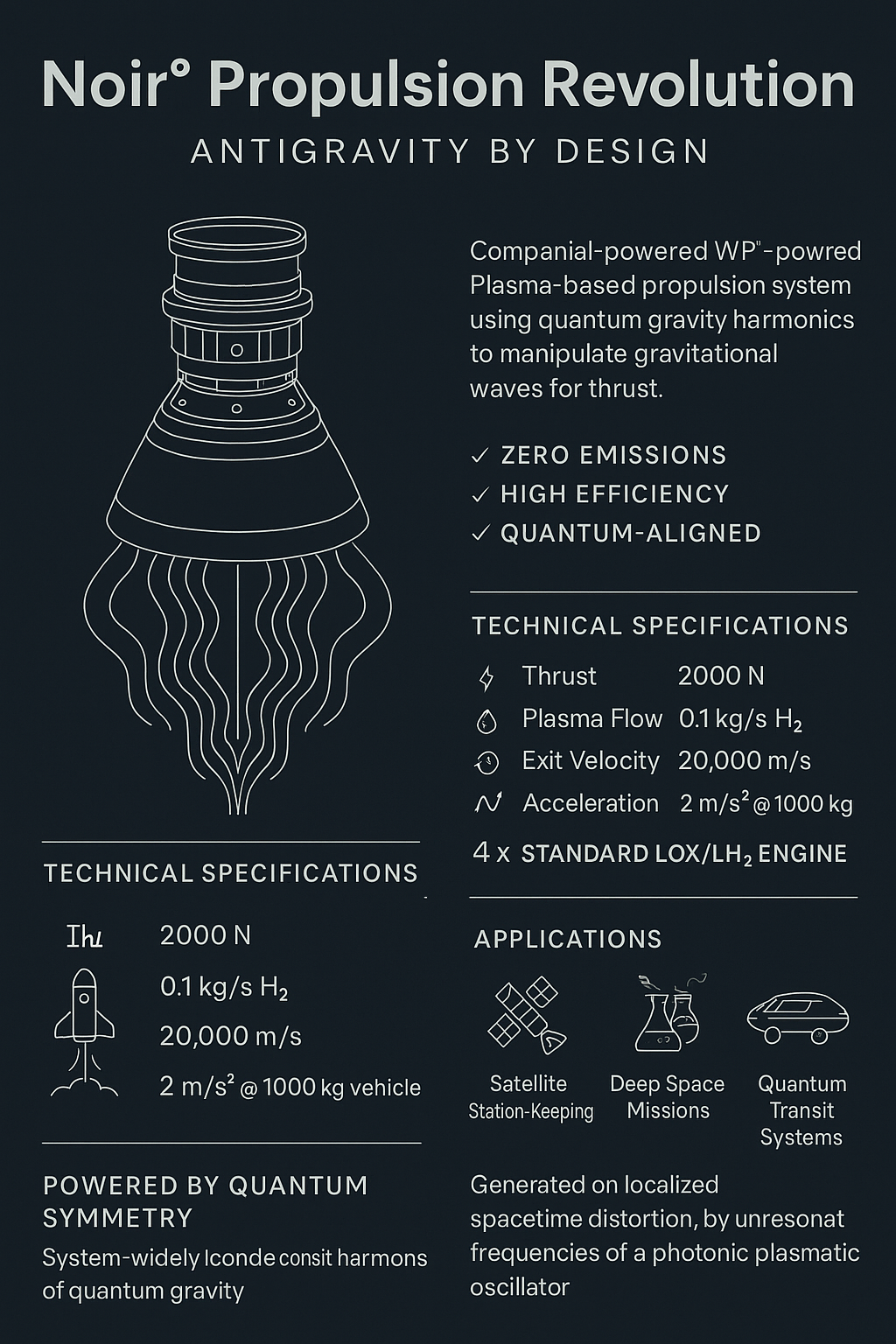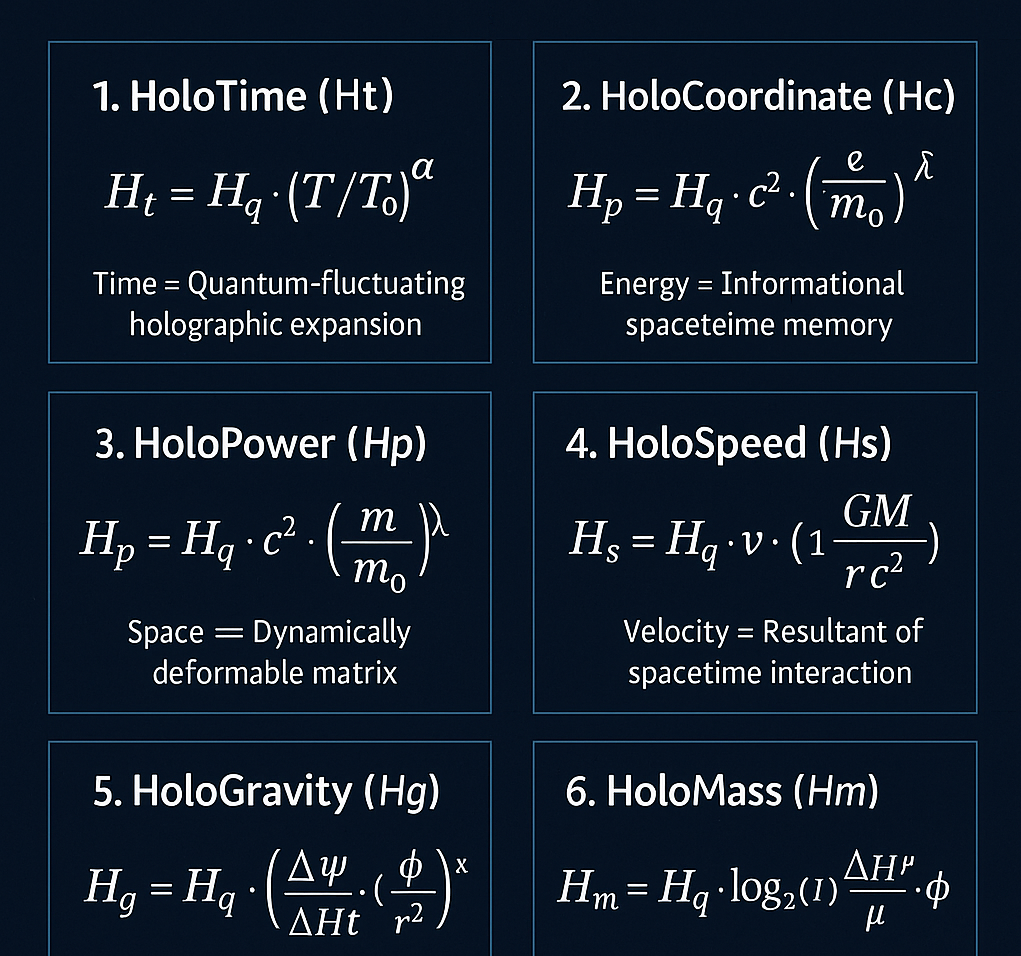Quantum Architecture of Time and Space | HoloHarmoniq Concept
HoloHarmoniq's Concept of Antigravity Mobility
Not a Sci-Fi Dream, But Reality in Motion!
Revolutionary Physics Meets Cutting-Edge Tech!
🔹 Not Classical Antigravity – We don’t break physics, we redefine it! Our system blends
force reformulation, electromagnetic levitation, resonance, and space-time manipulation to achieve next-gen mobility.
🔹 Stable Levitation, Zero Turbulence – Forget traditional aerodynamic or magnetic constraints!
Our system enables precise force and motion control for smooth, uninterrupted levitation.
🔹 Holographic Control – Real-time adaptive navigation ensures dynamic
balance and levitation, making movement flawless and futuristic!
The future isn’t coming… it’s already here!
Ready for the next era of mobility? Stay tuned!
HoloHarmoniq – Advancing the Future
For HoloHarmoniq, every step we take is aimed at advancing scientific innovation and global development. Our project aims to realize the technologies of the future based on the best possible scientific foundations, combining theoretical research with practical applications.
We are currently working on serious academic and research institute collaborations that will allow us to further develop the principles of HoloHarmoniq in recognized and prestigious institutions of the scientific community.
These partnerships not only support theoretical scientific work, but also contribute to our project having a real social and environmental impact. Through collaborations, the latest research results and the most innovative technological solutions can be integrated into HoloHarmoniq’s development processes, facilitating the successful and sustainable implementation of our project.
Why is academic collaboration important to us?
Science-based approach: Combining basic research and applied sciences allows us to build a solid foundation for the future.
Sustainable development: Striking a balance between environmental concerns and new technological applications.
Global collaborations: Through universities and research institutes, real international cooperations are created, which facilitate the global spread of HoloHarmoniq.
We are proud to implement our project together with leading experts in science and technology, who contribute not only with their knowledge, but also with their commitment to achieving our common goal: creating a better future.
The next step is the construction of the HoloLab, which is a key stage of the project. The technology we are developing here will not only mark a new milestone for the scientific community, but also set a new direction for all of humanity.
The future begins now, and we will work together to make the world a better place.
The HoloArk spacecraft technology is the foundation of future space travel, where the combination of water-based propulsion, fusion energy, antigravity system, and AI and robotics results in a revolutionary, highly energy-efficient and highly maneuverable vehicle. These innovative solutions not only create the possibility of long-term space travel, but also open up new dimensions in space exploration and space conquest.
1. Water-based propulsion - Detailed specifications
A. System architecture
• Electrolysis module:
o Nanotechnology-coated electrolytic cells: These cells provide an exceptionally high surface area ratio, which improves the speed and efficiency of molecular decomposition.
o Intelligent material exchange systems: By-products (such as oxygen) generated during the process are continuously monitored by sensors, and this data is integrated into the overall energy distribution system.
• Fusion Chamber Integration:
o Quantum Calibration Unit: The fusion of hydrogen atoms occurs under precisely controlled conditions, through calibration procedures on the quantum scale.
o Microplasma Stabilizers: These devices ensure the stability of fusion reactions, preventing turbulent flows and thermal fluctuations.
B. Energy Optimization and Environmental Integration
• Dynamic Energy Flow Control:
The intelligent system continuously monitors the energy input and output of the propulsion unit, so it can adaptively modify the operating parameters to match the current phase of the mission.
• Eco-Management Module:
The system’s special algorithms help minimize energy losses and optimize water recycling, thus reducing the environmental impact of waste and by-products.
2. Fusion Energy System – Detailed Specifications
A. Reactor Technology
• Hybrid Fusion Reactor:
o Isotope Management: The system precisely doses different hydrogen isotopes (such as deuterium and tritium), optimizing the efficiency of the reaction.
o Magnetic Confinement: Strong, precise magnetic fields keep the plasma in a stable state, ensuring a continuous and controlled fusion process.
• Heat Exchange and Cooling System:
o Quantum Cooling Technology: Using special quantum cooling fluids, the system is able to maintain an extremely low temperature inside the reactor, thus preventing overheating.
o Heat Recovery Systems: The heat generated during the fusion process is partially recovered, thus further increasing the efficiency of energy distribution.
B. Safety and Control Mechanisms
• Multi-level Emergency Shutdown System:
Integrated sensors and algorithms monitor reactor parameters and automatically intervene if any abnormality is detected.
• Redundant Power Distribution:
Multiple independent circuit loops ensure that power distribution continues to be provided to critical systems in the event of a failure of any module.
3. Antigravity System – Detailed Specifications
A. Technological Basics
• Electromagnetic Field Generators:
o Precision Frequency Modulation: The generators are able to precisely control the frequency of the emitted electromagnetic waves, thereby achieving local distortion of the gravitational field.
o Variable Field Intensity: The system allows the gravitational effect to be “turned off” or reduced, thus adapting the propulsion to various maneuvers.
B. Integration with navigation systems
• Real-time space-time modeling:
The system combines the space-time model created based on incoming data with the settings of the antigravity modules, thus guaranteeing extraordinary maneuverability.
• Energy synchronization:
The antigravity modules are integrated with the fusion energy system, so that energy distribution is optimal and the entire system remains in balance.
4. AI and robotics-based navigation and control system - Detailed specifications
A. Hardware and sensor integration
• Multispectral sensor network:
o LIDAR, radar and optical sensors: These systems provide a 360-degree field of view and together are capable of mapping objects, obstacles and energy fields in space in real time.
o Thermal cameras and infrared sensors: To detect extreme temperature differences, which can be especially important for monitoring the environment of a fusion energy system.
B. Software and algorithms
• Deep Learning and neural networks:
The AI system continuously learns from incoming data streams, optimizing path planning and system response time. These networks are able to react to environmental changes, predict potential threats, and perform proactive maneuvers.
• Real-time decision-making:
Adaptive algorithms work at multiple levels:
o Low-level control: In situations that require rapid response,I
A. Life Support and Waste Management Systems
Closed Environment Life Support System (CELS):
Carbon Dioxide and Oxygen Recycling: The atmosphere is cleaned by an advanced CO₂ absorption and oxygen production system that can continuously renew the internal atmosphere.
Hygiene and Water Purification Modules: Water is fully recyclable, all used water is recovered, and nanotechnology helps remove bacteria and viruses in the cleaning processes.
B Sustainable Fuel and Resource Management
Bio-Energy and Organic Waste Utilization:
State-of-the-art bio-technological systems convert organic waste generated by the spacecraft crew into electricity, ensuring a continuous energy supply during missions.
Recycled Materials and Nanomaterials:
The internal structure and each of the HoloArk systems recycle materials available in space. The use of nanomaterials such as graphene and titanium composites in all critical components reduces waste and minimizes resource consumption.
. Communication and data transmission systems
A. Advanced data transmission and control infrastructure
15. QKD (Quantum Key Distribution) encrypted communication:
All communications on the spacecraft are secured with state-of-the-art quantum-based encryption. QKD technology allows for 100% data security, even over intergalactic distances.
16. Network connections with space stations and other vehicles:
The HoloArk's global communication system allows for data exchange with other spacecraft, space stations, and interplanetary colonies. The system is able to autonomously select the optimal transmission channel for the best speed and reliability.
17. B. Adaptive Navigation and Target Approach Algorithms
18. Space-time Curvature-Based Navigation:
Advanced AI algorithms are able to adapt to the changing conditions of space, optimizing maneuvers to reach the target while also taking into account gravitational anomalies.
19. Direction-Indicating Systems:
Accurate positioning is provided by the HoloArk's built-in positioning system, which collects all available astronomical and space physics data and offers the ideal navigation path based on artificial intelligence.
21. 7. HoloArk Spacecraft Mission and Operations Systems
22. A. Research and Exploration
23. Exobiological Research:
The HoloArk is prepared for research on distant planets, especially in the field of exobiology.
Built-in science systems use a variety of sensors and microscopes to search for microscopic life forms on alien planets.
24. Fusion Environment and Planet Shaping Technology:
The HoloArk also uses unique fusion energy to terraform distant planets, which includes oxygenating
the atmosphere and creating water resources on the planet's surface. This is not only suitable for research, but also provides an opportunity to establish new colonies.
25. B. Colonization Module
26. Planetary Colonization Preparation:
The HoloArk plans in advance the establishment of human settlements on newly discovered planets.
Its capabilities include the production of water and oxygen, as well as the automated construction of habitation modules.
27. Adaptive Biological Systems:
The HoloArk's built-in biological systems adapt to new environments, allowing humans to provide the most favorable conditions for new colonies.
29. 8. Future Developments and Directions
30. A. Quantum-Based Developments
31. Integration of Quantum-Based Materials and Technologies:
HoloArk plans to integrate the latest quantum technologies, such as quantum-based materials
, which are extremely robust and extremely lightweight, providing the spacecraft with maximum mobility.
32. B. Autonomous and self-decision-making AI systems
33. Autonomous mission control:
In future developments, AI systems will provide full autonomy, allowing HoloArk to conduct
entire missions without human intervention, which will play a key role in space exploration and colonization.
35. 9. Safety and Emergency Systems
36. A. Emergency Shutdown Systems and Disaster Response
37. Automatic Leakage and Emergency Response Systems:
In the event of any type of failure, the AI systems respond immediately, ensuring tha
t all critical systems are automatically shut down while all others are put into safe mode.
38. Evacuation Protocols Designed for Extreme Circumstances:
The HoloArk is equipped with evacuation modules to safely evacuate
all of its crew, minimizing risks even in the most unexpected circumstances.
“We do not own the future. We give it as a gift. Knowledge sets you free.” HoloHarmoniq Team!
THIS IS NOT A THEORY. THIS IS A DECLARATION.
We don’t ask for permission anymore. The sky is no longer the limit.
We’re not coming in peace. We’re coming in truth.**
A New Definition of Gravity
Gravity is not a traditional, gravitational force, but a quantum-time-based interference phenomenon
in which holographic phase distortions and quantum phase shifts of spacetime create a
resonant “falling valley”. In this resonance, objects do not move under the influence of force,
but align themselves into the optimal phase of the quantum information spacetime pattern,
which represents the minimum of energy-coded tension. Thus, gravity is essentially a quantum
interference harmony of spacetime, resulting from the synchronized time-phase attraction between bodies.
This formula shows that gravity is not a "force", but a quantum-time-based phase interference,
in which objects "fall" into the resonance valley due to the most optimal time-phase harmonization.
Mass Redefined
Mass is not just matter, but a quantum information holographic imprint, created by the preservation
of complex interference patterns and time-based quantum states of spacetime. This imprint is the
result of distortions arising from the information content of the system and the temporal holographic
differences that determine the amplitude of the local spacetime field of a given object. Thus, mass is
the “memory” of spacetime itself, the quantum state that the holographic universe preserves in
time and that we perceive as the gravitational effect.
This formula shows that mass is nothing more than the holographic “memory” of spacetime –
the time-based quantum imprint that the holographic universe preserves.
This is not a flawless or finished theory, but the beginning of a scientific revolution that seeks
a deeper understanding of reality - in the language of information, phase interference and holographic patterns.
We remain open to professional dialogue, critical feedback and collaboration to jointly shape the science of the future.
Join us on this exciting journey!







